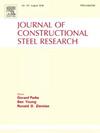Buckling of circular cylindrical shells under external pressures - A critical review
IF 4
2区 工程技术
Q1 CONSTRUCTION & BUILDING TECHNOLOGY
引用次数: 0
Abstract
Circular cylindrical shells are prone to buckling failure under different types of external pressure. These can include uniform lateral pressure, hydrostatic pressure (uniform lateral plus end pressure), and non-uniform wind pressure. The focus of this study is to thoroughly examine the available formulas for calculating the buckling pressure of circular cylindrical shells under these various types of external pressure and to assess their limitations. The study delves into a dozen of simplified formulas drawn from literature, discussing their derivations and comparing them with the exact solution of the problem to unveil their constraints. The study also investigates the correlations between uniform lateral and wind pressures, the effects of geometrical and material nonlinearities, and the impact of imperfections. The findings confirm that hydrostatic buckling pressure is consistently lower than lateral buckling pressure, and the conditions under which the difference between the two is negligible have been refined. It was found that the difference in buckling pressures is insignificant (less than 5 %) for length-to-radius ratios greater than 1.0. Additionally, two simplified formulas from the dozen compared were identified as particularly reliable, yielding accurate results across a wide range of shell geometries. The study further revealed that the discrepancy between theoretical and experimental buckling stresses increases as the length-to-radius ratio decreases, with the effect becoming particularly pronounced for short shells with length-to-radius ratios below 1.0. Finally, the study summarizes key aspects related to the stability of circular cylindrical shells, including imperfection sensitivity, lower bound estimates, and stiffener requirements.
外压作用下圆柱壳的屈曲。评述
圆柱壳在不同类型的外压作用下容易发生屈曲破坏。这些包括均匀侧压、静水压力(均匀侧压加端压)和非均匀风压。本研究的重点是彻底检查在这些不同类型的外部压力下计算圆柱壳屈曲压力的现有公式,并评估其局限性。这项研究深入研究了从文献中得出的十几个简化公式,讨论了它们的推导,并将它们与问题的精确解进行了比较,以揭示它们的约束条件。该研究还调查了均匀侧压和风压之间的相关性,几何和材料非线性的影响,以及缺陷的影响。研究结果证实,静水屈曲压力始终低于侧向屈曲压力,并且改进了两者之间差异可以忽略不计的条件。研究发现,当长径比大于1.0时,屈曲压力的差异不显著(小于5%)。此外,经过比较的12个简化公式中,有两个公式被认为是特别可靠的,可以在广泛的壳体几何形状范围内得到准确的结果。研究进一步表明,随着长径比的减小,理论屈曲应力与实验屈曲应力之间的差异增大,对于长径比小于1.0的短壳,这种影响尤为明显。最后,研究总结了与圆柱壳稳定性相关的关键方面,包括缺陷敏感性、下界估计和加强要求。
本文章由计算机程序翻译,如有差异,请以英文原文为准。
求助全文
约1分钟内获得全文
求助全文
来源期刊

Journal of Constructional Steel Research
工程技术-工程:土木
CiteScore
7.90
自引率
19.50%
发文量
550
审稿时长
46 days
期刊介绍:
The Journal of Constructional Steel Research provides an international forum for the presentation and discussion of the latest developments in structural steel research and their applications. It is aimed not only at researchers but also at those likely to be most affected by research results, i.e. designers and fabricators. Original papers of a high standard dealing with all aspects of steel research including theoretical and experimental research on elements, assemblages, connection and material properties are considered for publication.
 求助内容:
求助内容: 应助结果提醒方式:
应助结果提醒方式:


